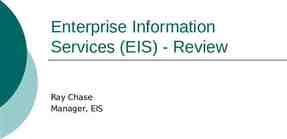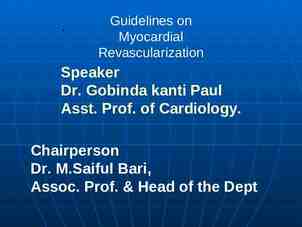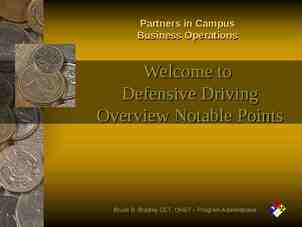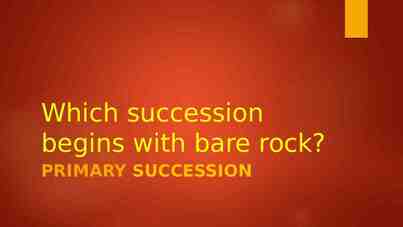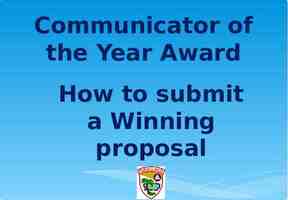Chapter 5 Motivation: From Concepts to Applications Stephen P. Robbins
18 Slides1.82 MB

Chapter 5 Motivation: From Concepts to Applications Stephen P. Robbins 2003 Prentice Hall Chapter 5 Robbins 1

Objectives Identify the four ingredients common to MBO programs Outline the five-step problem-solving model in OB Modification Explain why managers might want to use employee involvement programs Contrast participative management with employee involvement Explain how ESOPs can increase employee motivation Describe the link between skill-based pay plans and motivation theories 2003 Prentice Hall Chapter 5 Robbins 2

t n e m e g a n a M ) O B M ( s e v i t c by Obje ll a r e v o g in t r e v n Emphasizes co to n i s e v ti c je b o l a organization al u d i iv d in r o f s e v specific objecti e r a t a h t s r e b m e units and m ble a r u s a e m d n a , le tangible, verifiab 2003 Prentice Hall Chapter 5 Robbins 3

Cascading of Objectives Overall Overall organizational organizational objectives objectives Divisional Divisional objectives objectives Departmental Departmental objectives objectives Individual Individual objectives objectives 2003 Prentice Hall Chapter 5 Robbins 4

Management by Objectives Four ingredients common to MBO programs: 1. Goal specificity 2. Participative decision making 3. Explicit time period 4. Performance feedback 2003 Prentice Hall Chapter 5 Robbins 5

Management by Objectives (MBO) Organizational objectives translated to specific objectives for each level (division, department, individual) Lower-level managers participate in setting their own goals Results in hierarchy of objectives that links one level to the next If all individuals achieve goals, organizational objectives will be attained 2003 Prentice Hall Chapter 5 Robbins 6

n o i t a c i f i d o Behavior M (OB Mod) nt e m e c r o f in e r f o The application rk o w e h t in ls a u d i theory to indiv g in lv o s m e l b o r p setting using a ive it s o p d n a , k c a b model, feed reinforcements 2003 Prentice Hall Chapter 5 Robbins 7

11 Identify Identify performanceperformancerelated related behavioral behavioral events events 33 22 Measure: Measure: Baseline Baselinethe the frequency frequency of ofresponse response Identify Identifyexisting existing behavioral behavioral contingencies contingencies through through functional functional analysis analysis 4a 4a Develop Develop intervention intervention strategy strategy 4b 4b Apply Apply appropriate appropriate strategy strategy Steps in OB Mod No 55 Evaluate Evaluatefor for performance performance improvement improvement 4d 4d Maintain Maintain desirable desirable behavior behavior Yes Problem Problem solved? solved? Adapted by permission of the publisher from Personnel, Personnel, July-August 1974. Fred Luthans, American Management Association, New York. All rights reserved. 2003 Prentice Hall Chapter 5 Robbins 4c 4c Measure: Measure: Chart Chartthe the frequency frequency of ofresponse response after after intervention intervention 8

n o i t i n g o c e Employee R Programs d r a w e r o t s e c r u o Using multiple s cly li b u p e iz n g o c e r behavior and p u o r g d n a l a u id both indiv s t n e m h s li p m o c ac 2003 Prentice Hall Chapter 5 Robbins 9

Employee Recognition Programs Rewarding behavior with recognition immediately leads to its repetition To maximize motivation potential, publicly communicate who and why is being recognized Recognizing employee’s superior performance often costs little Suggestion systems are widely used recognition devices 2003 Prentice Hall Chapter 5 Robbins 10

t n e m e v l o v Employee In es s u t a h t s s e c o r p A participative es e y lo p m e f o y it c the entire capa ct e ff a t a h t s n io is c related to de e g a r u o c n e o t d e them is design e h t o t t n e m it m m o increased c ss e c c u s 's n io t a iz n orga 2003 Prentice Hall Chapter 5 Robbins 11

Employee Involvement Involve workers in decisions that will affect them Increase their autonomy and control over their work lives Include techniques with a common core Employee participation Participative management Workplace democracy Empowerment Employee ownership 2003 Prentice Hall Chapter 5 Robbins 12

s m a r g o r P y Variable-Pa re a e h w n io t a s n e p Forms of com is y a p ’s e e y lo p portion of an em of e r u s a e m e h t n based o e h t f o r e h it e e c performan or , n io t a iz n a g r o e h individual, t both 2003 Prentice Hall Chapter 5 Robbins 13

Variable-Pay Programs Four widely used variable-pay programs Piece-rate wages - fixed sum for each unit completed Bonuses - a percent of annual pay based on company earnings Profit sharing - based on a formula designed around company’s profitability Gainsharing - formula-based group incentive plan for improvements in productivity 2003 Prentice Hall Chapter 5 Robbins 14

y a P d e s a B Skill y) a P d e s a B y c (Competen w o h n o d e s a Pay levels b e v a h s e e y o l p many skills em o d n a c y e h t s or how many job 2003 Prentice Hall Chapter 5 Robbins 15

Skill-Based Pay Advantages: Attractive due to flexibility for management Encourages employees to acquire a range of skills Facilitates communication and understanding of others’ jobs Meets needs of ambitious employees without a promotion in job title Disadvantages: Topping out - learning all the skills Skills might become obsolete Do not address level of performance 2003 Prentice Hall Chapter 5 Robbins 16

Implications for Managers Programs designed to increase employee motivation, productivity, and satisfaction are grounded on basic motivation theories Six motivation programs described are not applicable to every organization or every manager’s needs Understanding will help with designing internal systems to increase employee productivity and satisfaction 2003 Prentice Hall Chapter 5 Robbins 17

Summary Identified the four ingredients common to MBO programs Outlined the five-step problem-solving model in OB Modification Explained why managers might want to use employee involvement programs Contrasted participative management with employee involvement Explained how ESOPs can increase employee motivation Described the link between skill-based pay plans and motivation theories 2003 Prentice Hall Chapter 5 Robbins 18


